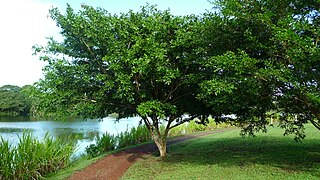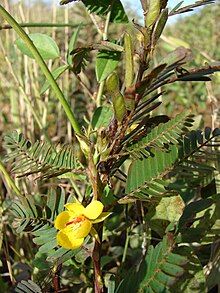
The Mimosoideae are a traditional subfamily of trees, herbs, lianas, and shrubs in the pea family (Fabaceae) that mostly grow in tropical and subtropical climates. They are typically characterized by having radially symmetric flowers, with petals that are twice divided (valvate) in bud and with numerous showy, prominent stamens.

Bauhinia is a large genus of flowering plants in the subfamily Cercidoideae and tribe Bauhinieae, in the large flowering plant family Fabaceae, with a pantropical distribution. The genus was named after the Bauhin brothers Gaspard and Johann, Swiss-French botanists.

Cassia is a genus of flowering plants in the legume family, Fabaceae, and the subfamily Caesalpinioideae. Species are known commonly as cassias. The genus includes 37 species and has a pantropical distribution. Species of the genera Senna and Chamaecrista were previously included in Cassia. Cassia now generally includes the largest species of the legume subtribe Cassiinae, usually mid-sized to tall trees.

Calliandra is a genus of flowering plants in the pea family, Fabaceae, in the mimosoid clade of the subfamily Caesalpinioideae. It contains about 140 species that are native to tropical and subtropical regions of the Americas.

Senna, the sennas, is a large genus of flowering plants in the legume family. This diverse genus is native throughout the tropics, with a small number of species in temperate regions. The number of species is estimated to be from about 260 to 350. The type species for the genus is Senna alexandrina. About 50 species of Senna are known in cultivation.

The subfamily Detarioideae is one of the subdivisions of the plant family Fabaceae (legumes). This subfamily includes many tropical trees, some of which are used for timber or have ecological importance. The subfamily consists of 84 genera, most of which are native to Africa and Asia. Pride of Burma and tamarind are two of the most notable species in Detarioideae. It has the following clade-based definition:
The most inclusive crown clade containing Goniorrhachis marginataTaub. and Aphanocalyx cynometroidesOliv., but not Cercis canadensisL., Duparquetia orchidaceaBaill., or Bobgunnia fistuloides(Harms) J. H. Kirkbr. & Wiersema.

Zygia is a genus of flowering plants in the family Fabaceae. It includes 60 species of tres and shrubs native to the tropical Americas, from Southern Mexico and Cuba to northern Argentina. Typical habitats are tropical forest and coastal zones, generally below 900 meters elevation with a few species extending up to 2800 meters. It belongs to the mimosoid clade of the subfamily Caesalpinioideae.

Entada is a genus of flowering plants in the family Fabaceae, in the mimosoid clade of the subfamily Caesalpinioideae. It consists of some 30 species of trees, shrubs and tropical lianas. About 21 species are known from Africa, six from Asia, two from the American tropics and one with a pantropical distribution. They have compound leaves and produce exceptionally large seedpods of up to 1.5 metres (4.9 ft) long. Their seeds are buoyant and survive lengthy journeys via rivers and ocean currents, to eventually wash up on tropical beaches.

Aeschynomene is a genus of flowering plants in the family Fabaceae, and was recently assigned to the informal monophyletic Dalbergia clade of the Dalbergieae. They are known commonly as jointvetches. They range across tropical and subtropical regions of the Americas, sub-Saharan Africa, south, southeast, and east Asia, and Australia. These legumes are most common in warm regions and many species are aquatic.

Senegalia is a genus of flowering plants in the family Fabaceae. It belongs to the Mimosoid clade. Until 2005, its species were considered members of Acacia. The genus was considered polyphyletic and required further division, with the genera Parasenegalia and Pseudosenegalia accepted soon after.

Vachellia is a genus of flowering plants in the legume family, Fabaceae, commonly known as thorn trees or acacias. It belongs to the subfamily Mimosoideae. Its species were considered members of genus Acacia until 2009. Vachellia can be distinguished from other acacias by its capitate inflorescences and spinescent stipules. Before discovery of the New World, Europeans in the Mediterranean region were familiar with several species of Vachellia, which they knew as sources of medicine, and had names for them that they inherited from the Greeks and Romans.
Pityrocarpa is a genus of flowering plants in the family Fabaceae. It includes seven species of shrubs and small trees native to the tropical Americas, including western and southeastern Mexico, Guatemala and El Salvador, Venezuela and Guyana, Bolivia, and eastern Brazil. Native habitats include tropical coastal rain forest, gallery forest, secondary forest, woodland, wooded grassland (Cerrado), and thorn scrub (Caatinga). It belongs to the mimosoid clade of the subfamily Caesalpinioideae.

Harpalyce is a genus of flowering plants in the family Fabaceae. It belongs to the subfamily Faboideae. It includes 35 species of shrubs and small trees native to the tropical Americas. Their distribution is disjunct, ranging from Mexico to Nicaragua, Cuba, and northern to southeastern Brazil and Bolivia. Typical habitats include seasonally-dry tropical forest, warm-temperate humid forest, woodland, bushland and thicket, shrubland, and grassland. Most species are evergreen and flower during the dry season.












